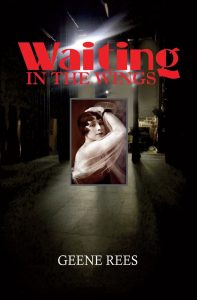Just not for me…
I recently read two books , well one I read and the other I abandoned, but neither were for me. I’ve decided that’s OK, as Simon, one of my favorite book bloggers says — someone else may love these novels.
 This is Your Life, Harriet Chance!
This is Your Life, Harriet Chance!
by Jonathan Evison
I was initially drawn to this novel, because of its unique premise, which mirrors the 1950’s television series “This is your life”. In the show, a famous person’s life was re-told with flashbacks to life changing moments, the places they lived, the important people who played a vital part in said lives. See a sample of the show HERE.
The cover gives the appearance of a light-hearted novel (there I go again judging a book by its cover). Harriet is 78, her husband has recently died and she decides to go on an Alaskan cruise he planned before he got Alzheimer’s.
Ahh, a cheery-new-lease-on-life story you would think…but we are being led terribly astray. There is nothing cheery about Harriet Chance’s life.
Like the television show, we go back and forth in time to experience Harriet Chance’s life. But her life is littered with bitter heartbreak. There are betrayals at every turn. And the litany of tragedy goes on and on — there’s child molestation, rape, unwanted pregnancy, unfaithful marriage, alcoholism, drug addiction and as a final blow, bitter adult children trying to get her money. After awhile, I stopped keeping count of the awful events in hapless Harriet’s life.
As added angst, Harriet’s mean, dead husband appears to her in a caught-between-life-and-death role, which never feels fully developed and causes Harriet’s children to harbor suspicions about their mother’s mental stability.
The author is remorseless in his portrayal of seniors and dementia. Harriet herself is characterized as a terrible mother, a distant wife and a bitter old women. Her husband’s Alzheimer’s is portrayed with sneering and unfeeling sarcasm.
I kept reading, hoping for a ray of sunshine in this story, some sort of redeeming act or event that would make Harriet’s life, if not great, then at least OK. But nope, there is nothing — nothing to resurrect poor Harriet’s life
This is Your Life Harriet Chance! (I never really got the use of the exclamation point) is well written, but one of the most depressing books I have ever read.
A digital review copy was provided by Algonquin Books via NetGalley
The Bookshop on the Corner
by Jenny Colgan
 The Bookshop on the Corner, came home with me from the library’s new arrivals shelf. I’m a sucker for a book about books or a bookshop and this one is set in Scotland – double points. Took it to bed with me that evening and set it down after five or six chapters and went to sleep somewhat disappointed.
The Bookshop on the Corner, came home with me from the library’s new arrivals shelf. I’m a sucker for a book about books or a bookshop and this one is set in Scotland – double points. Took it to bed with me that evening and set it down after five or six chapters and went to sleep somewhat disappointed.
In the morning I checked some of the reviews and publicity for this novel and found I was in the distinct minority. Ms. Colgan’s novel has been liked by one and all — just not me.
Nina, a recently laid-off librarian decides to travel to one of Scotland’s remotest areas. She discovers their library is closed and there is no bookmobile. So she decides to move up there with her vast collection of books and buy a van from which to sell her books throughout this remote corner of Scotland. Ah ha, this book is not about a bookshop, it’s about a book van – well I guess that’s OK, I’ll keep reading. After all Parnassus on Wheels was one of my favorite books.
But, turns out this is chick lit – disguised as a book for book lovers. Straining all credibility, there’s a handsome train engineer who leaves Russian poetry books for Nina in tree branches – really?. And just as in The Little Paris Bookshop, Nina feels compelled to recommend books to solve every problem or malady, with trite results.
I finally returned the book to the library, when I got tired of the Scots Nina encounters being uncharitably portrayed as if caricatures — less than bright and seldom clean.
I just couldn’t take any more.
Waiting in the Wings by Geene Reese
Waiting in the Wings, by Geene Reese
Even though I’ve lived in San Francisco for 35 years, I never tire of its physical beauty, architecture, diverse culture, and most of all, this city’s colorful, and often, disreputable history.
So, I was very excited to receive Waiting in the Wings, a historical novel set in prohibition-era San Francisco and based on the true story of the author’s great aunt.
From the introduction: Hidden in a compartment of my grandmother’s bottom dresser drawer was an old scrapbook. Pressed inside were photographs of a beautiful young woman and hundreds of newspaper clippings about vaudeville shows and the movie industry. This, is how I learned about my great aunt Ruby Adams.
This is no dry historical biography, in just the first pages, both Ruby, a beautiful, spunky vaudeville performer, and 1920’s era San Francisco sparkle to life. For a San Franciscan, the opening chapter is pure delight as we walk the sidewalks of the city with Ruby — leaving the original St. Francis Hotel, crossing street-car-crowded Market Street, and into the historic Strand theater. On our way, doormen greet her and others smile in delight –everyone knows Ruby and her delightful vaudeville review.
This is a time of transition for vaudeville theater, as the moving picture industry is starting to encroach. Ruby, with her striking looks, is contemplating a move to moving pictures, but still gaily performs her vaudeville routine in the historic theater where she practically grew up.
We join Ruby as she prepares for her nightly performance, observing both the back stage workings and the show performance itself. We are also with Ruby, that fateful evening, when she is injured in a back stage accident.
Ruby’s injuries are extensive and the accident, upon investigation, reveals negligence. Her career over, Ruby files a lawsuit…and here Waiting in the Wings takes a compelling turn. Ms. Reese takes us into the corruption and prevailing attitudes of the time, with unscrupulous lawyers and shady dealings behind the scenes.
At this point in the novel, some non-San Franciscans may get bogged down with the name dropping. And yes, there are numerous names to keep track of — greedy politicians, questionable judges, and shady lawyers. Many of these names are still famous here today — Spreckles, Newsom, Davis –and, while I found it rough going at times, it was still fascinating.
Throughout it all, Ruby is resilient and carries on with unflagging spirit. There is romance as Ruby is buoyed through the ordeal by the affection of quirky, but lovable, speakeasy owner “Coffee Dan”.
This story of legal shenanigans and “death by a thousand delays” moves ahead with the help of actual newspaper clippings (with photos) and snippets of court documents. I won’t spoil the outcome, except to say, the case ends up in Superior Court. I found Waiting in the Wings fascinating and compulsive. I had to keep reading to find out what happens to our brave Ruby Adams.
It is clear that Ms. Reese did an enormous amount of research. This gives Waiting in the Wings pitch perfect realism — from the jargon and dialogue of the era, to the weather, the newspapers of the time, even the popular boxed candy gifts of the era (some still in business today).
But, most strikingly, this realism allows the reader a time capsule view of 1920’s San Francisco — with lovingly re-created scenes that pull from our city’s rich history, buildings, diverse neighborhoods and the never-ending, conga line of eccentric and questionable characters — nothing much has changed.
A copy of the book was provided by the author, in exchange for a honest review.
The Light Between Oceans by M.L. Stedman
Some people have this problem…
I never do, I always — always race to read the book before seeing the film. I even avoid the trailers as I don’t want the character images in my head shattered by the Hollywood portrayal.
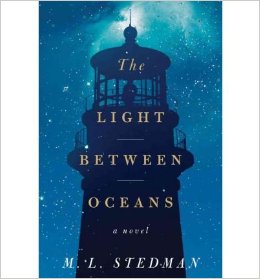 The Light Between Oceans is a enthralling tale, capturing me from this first line:
The Light Between Oceans is a enthralling tale, capturing me from this first line:
On the day of the miracle, Isabel was kneeling at the cliff’s edge, tending the small, newly made driftwood cross,
This is a debut novel by M.L. Stedman, who was born and raised in Western Australia. Her knowledge and descriptions of the coast of Australia are beautifully rendered. There’s even a map at the beginning. (I love me a map with a novel). The author has also done her homework on light houses — but I’m getting ahead of myself.
Tom Sherbourne has miraculously survived World War I, but only just. Still shattered, he is hired to keep the lighthouse on Janus, an island off the coast of Australia. As the sole inhabitant of the tiny island, he finds comfort with the precision and routine of manning the lighthouse;
Stick to the solid. To the brass fittings which had to be polished, the glass which had to be cleaned. Getting the oil in, keeping the cogs moving, topping up the mercury to let the light glide. He gripped each like a rung of a ladder, by which to haul himself back to the knowable; back to his life.
But then during a break on the mainland, he falls in love with Isabel, they marry and return to the island to run the lighthouse together. The chapter where he shows Isabel around the lighthouse and explains how it works is pure magic with lovely descriptive writing. Isabel sees the lighthouse as…”a palace of prisms, like a beehive made of glass”.
At this point in the story I believe the reader should adapt what is called a willing suspension of disbelief. Isabel and Tom have suffered two miscarriages and tragically, a third stillbirth.
A few weeks later, a canoe washes ashore containing a dead man and a live baby girl. Tom wants to report the dead man and take the baby to the mainland to find her family — but Isabel begs him to keep the child. He reluctantly agrees and this begins the cycle of consequences.
Thus, the suspension of belief – I kept reading, entranced but amazed at their actions. They bury the man and keep the baby. Both Tom and Isabel fall completely in love with the little girl they name Lucy. When they found Lucy, all that was with her was a beautiful silver rattle. There is no other identification.
Do they wonder about the baby’s grieving family on the mainland? Don’t they want to know the circumstances of the man’s death, not to mention his identity? Aren’t they concerned by the fact that they have broken the law? The couple suspend all rational actions and thoughts, and they blithely build their idyllic life on the island, with their magic baby.
Now dear readers, we’re at the middle of the novel and this is where my willingness to suspend belief almost became a willingness to suspend reading. But, I had to carry on, keenly interested to know the outcome for our little family on the island.
Now we read through redundant circles of Tom grappling with his love and loyalty to Isabel and his sense of morality of what they have done We experience the anguish and consequences of the decisions made, and not made. We meet the real mother and discover how nothing is purely right or wrong — all beautifully written but overwrought. In the back of my mind I kept thinking, “This would make a great film”.
The second half of the book is stoked with pathos and emotions on full power. And the ending, though probably right and ultimately quite moving, leaps over many of the key events – leaving much for the reader to question.
I gave my copy of The Light Between Oceans to a departing house guest and decided to only say, “this will be a great plane book” – which I am positive it will be.
Because, despite my criticisms, I was smitten by this best-seller and I kept reading to the end. I’m sure it will make a lovely, tear jerking, Hallmark sort of film — not to mention, a very successful new author.
If you want to see the film trailer before reading this novel you can see it HERE.
A Great Reckoning by Louise Penny
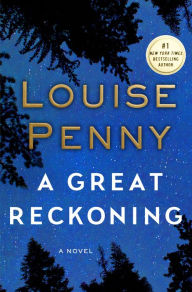 A Great Reckoning by Louise Penny
A Great Reckoning by Louise Penny
It’s finally here! Today, the new Louise Penny is released. Now, if you took my previous post heed, you called in sick to work, cancelled all appointments, and this morning, you were at your local independent bookstore as it opened. Now you’re installed in a coffee shop or back home about to settle in with this latest installment in Ms. Penny’s stellar Inspector Gamache series.
So how to tell you about A Great Reckoning without giving too much away? Very carefully, I promise, no spoilers here.
I can start by admitting I fell hard for this book and didn’t come up for air for a couple of days (Husband calls this “she who is with book” and gamely forges for his own dinner and watches TV on low volume.)
A Great Reckoning opens in Three Pines where Gamache and Reine-Marie are still living their idyllic life in the village (how they both don’t weigh 300 pounds is beyond comprehension);
The next morning Reine-Marie invited her husband to breakfast at the bistro. Henri came along and lay quietly under their table as they sipped bowls of café au lait and waited for their maple-cured bacon with scrambled eggs and Brie. The fireplaces on either end of the long beamed room were lit and cheerful, conversation mingled with the scent of wood smoke, and there was the familiar thudding of patrons knocking snow from their boots as they entered.
I can also tell you, that the mystery begins with an old map found boarded up in the walls of the bistro. At first, the map seems to be no more than a curiosity. But the map uncovers village secrets from WW I, and leads Gamache to an old friend, and even older adversary and to places he wishes not to re-visit.
Gamache, the retired Chief of Homicide for the Sûreté du Québec has been taken out of retirement and assigned to takeover the Süreté ‘s cadet training academy. Gamache seems invigorated and firing on all cylinders as he confronts corruption, greed and possible abuse at the cadet academy.
Ms. Penny always has a theme running through her novels and A Great Reckoning is about misfits and the myriad ways they are flawed and judged. Misfits who have been wounded but survive and learn to thrive – and even shine. (Ruth and her foul mouthed duck are, of course, a prime example of such shining misfits.) From the cadets at the academy, to Gamache’s old friend, to the commanding officers at the academy – we recognize these misfits at every turn. Yet they are depicted with compassion and intelligence. Once again, Ms. Penny brings humanity to even her most damaged and suspect characters.
A Great Reckoning, like all the others in this series, is chocked full of fascinating historical and cultural perspectives. This time we learn about maps, early map makers and their vital role in uncharted territory explorations. In terms of current culture, there’s always some new insights for non-Canadians. We get a glimpse into maple sugaring and a typical “sugar shack” as well as, the oddities of Quebéc communications;
They were in the odd position, as sometimes happened in Quebéc, where the Francophone was speaking English and the Anglo was speaking French.
But some of the observations are applicable to any country and its politics:
“A man driven by an infected ego. But he was also a powerful man, I’ll give him that. A charismatic personality. Stupidity and power. A dangerous combination, as we’ve found out many times, eh Armand?”
Long time fans of Ms. Penny will be pleased with the delightful humor and witty rapport between the quirky, but lovable, Three Pines villagers;
Myrna sat down heavily on her side of the sofa, almost catapulting Ruth into the air. “I always suspected Ruth would end up a stain on the wall,” Gabri said to Clara. “But, I never thought the ceiling.” He turned to Myrna. “I’ll give you five dollars to do that again.”
Ruth is her usual cranky self when confronting a breakfast meal being served for dinner;
“How long have I been asleep?” asked Ruth looking down at her plate. “Victoria is no longer on the throne, if that’s what you’re wondering,” said Myrna. “The good news is, we do have another queen,” said Oliver glancing at Gabri.
The final chapter – again I’m being careful not to give anything away — showcases some of Ms. Penny’s best writing with guns as metaphors and surrender of same — as redemption. I read it twice, as it was that subtly crafted.
But what brought actual tears to my eyes was after the novel ended — in the afterword. Here, Ms. Penny lovingly acknowledges Michael’s (her husband) dementia and writes of her gratitude to his doting caregivers, as well as her readers for giving her the support and encouragement to keep on writing despite this heartbreaking situation. (She’s already well into writing the next novel.)
So in summary, A Great Reckoning gets not only my glowing review, but a standing ovation.
If you’re new to Louise Penny’s intelligent, and often brilliant series, you should start at the beginning with her first, Still Life. You can see why she’s one of my most admired authors HERE, HERE and HERE.
Now I’m off to make something special for poor Husband’s dinner, — maybe a breakfast for dinner?
A digital review copy was provided by St. Martin’s Press via NetGalley
All the Light We Cannot See by Anthony Doerr
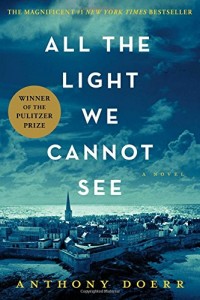 Last night, I closed All the Light I Cannot See and asked myself, what the heck happened to this beautiful novel? (OK I didn’t say heck, just trying to keep it clean here at Book Barmy.)
Last night, I closed All the Light I Cannot See and asked myself, what the heck happened to this beautiful novel? (OK I didn’t say heck, just trying to keep it clean here at Book Barmy.)
This WWII blockbuster opens with two riveting story lines. Werner, an orphan German teen is recruited by the Nazi’s for his invaluable radio engineering skills, and Marie-Laure, a blind French girl – separated from her adoring father in war-torn France. Right from the beginning, the reader knows that the lives of these two potentially fascinating characters will intersect.
The novel also has some captivating scenes, all beautifully written. There’s Marie-Laure reading aloud from her braille edition of 20,000 Leagues Under the Sea, there’s the ominous agenda inside Werner’s exclusive Nazi training school, and then, if you’re like me, you’ll hold your breath as messages are passed along, hidden in freshly baked bread, and then secretly broadcast from a short-wave radio hidden in the attic of a crumbling house perched on the edge of the sea. Everything is there — all the elements of a well-written and exciting WWII adventure.
And so you settle in, cup of tea in hand and eagerly start reading…and reading…and reading — through 178 chapters. Yes, you read that right — 178 chapters!
Therein lies the first problem — 178 short chapters, many only a few pages, which jerk the reader back in forth in time, often with no clue to the year. The choppy chapters and abrupt time jumps are not only confusing, they actually prevented me from really sinking into the story. One reviewer, knowing that Mr. Doerr is a much better writer than this, surmised his editors insisted on shuffling the timeline. The format did feel gimmicky and like an afterthought. I’d go even further, I think those same editors also insisted on chopping the novel into short chapters to cater to today’s 140-character-tweet-text-snapchat-attention-span readers (That just wrote itself in the throes of my rant – like it?).
Now we come to the second problem, All the Light We Cannot See starts out beautifully written and compelling, but then it just seems to fall apart — rather it just never comes together. Werner’s and Marie-Laure’s paths, while coming teasingly close, never really converge. And when they do finally intertwine, they are only together for 10 pages towards the end. Then fast forward 30 years and the book ends not with a bang but with a whimper (my apologies to T. S. Eliot).
The novel won Pulitzer Prize, earned many glowing reviews and many weeks on the bestseller lists. Perhaps I missed something magical in my reading of this book. Maybe it was my mood. Whatever the reason, I was underwhelmed and sadly disappointed upon finishing this novel.
A digital review copy was provided by Scribner via NetGalley.
The Stopped Heart by Julie Myerson
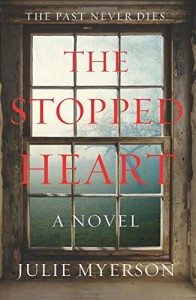 As a dedicated book
As a dedicated book maniac reviewer, I try and keep up with the cutting edge UK literary press. I’ve been intrigued by an emerging genre which I’ll call the ‘creepy yet quaint British village ghost story*’.
The Stopped Heart has been touted as such — a haunted house story set in the English countryside, with edge-of-your-seat suspense. Given its many stellar reviews and an enticing cover –I leapt in.
I know it’s been overdone, but The Stopped Heart is, at first, boringly set in two time periods, and (yawn) has two narratives – one in the present with Mary and Graham Coles – and the other, over 150 years ago with the farm family who once lived in the Cole’s cottage.
Delving further into what seems to be a predictable haunted tale, it’s not only the Coles’ cottage which is haunted — so are Mary and Graham. They have escaped to this countryside retreat to recover from a tragic loss. In the same cottage, 150 years in the past, Eliza narrates her large family’s hardscrabble farm story. Her sister, Lottie, strangely speaks of the present day family as if she knows them — and even names her kitten “Merricoles”, a version of the name “Mary Coles”. Ghosts, spirits, a haunted cottage — so far – so good, right? Get me another cup of tea and I’ll keep reading.
Except it all starts to go very, very wrong when the mysterious red-haired James Dix enters the circle of Eliza’s family. Thus begins the disturbing spiral involving both time periods and parallel stories of betrayal, underage lust and ultimately, grisly violence. And like an ill-advised roller coaster ride, you know, with dread, whats coming — but there is nothing you can do to get off. You’re strapped into the ride and you just gotta hang on and keep reading.
Ms. Myerson gives no indication when her narrative switches from one time period to another. I realized midway through the novel, that the author does this deliberately to enhance the fluidity of her past and present story-lines. The Coles’ modern-day cottage still harbors the violence of the past and Eliza and Lottie can sense the tragedy in the future. This can get confusing if you’re not paying attention. But, pay attention you will, because while creepy and often violent — The Stopped Heart is a compelling page turner. (Fair warning to any parents of young children out there, this book contains violence with young children as the victims.)
The modern day Coles struggle with their broken relationship, a surly teenage step-daughter and a sad flirtation with a neighbor. In the past, Eliza discovers her own budding sexuality, while simultaneously demanding her own (often funny and spunky) feminist beliefs. Meanwhile, the mysterious red-headed man disrupts everyone in both time periods. Some of the most intriguing writing involves Mary Coles “seeing” her kitchen and garden morph into the past. The smells, the dirt, the old furnishings all come alive through her eyes.
At the end of this gripping read, Ms. Myerson purposefully leaves many things unanswered – you won’t arrive a pat ending – creepily, you’ll continue to dwell on the events long after you’ve closed the book.
The Stopped Heart lead me to the edge of horror fiction, another blogger aptly labeled it “horror light”. I resolutely avoid horror fiction, I’m still recovering from my one (and only) Stephen King novel many years ago.
So why did I keep on reading well out of the limits of my comfort zone?
I kept turning the pages because of the writing. This is an intensely dark reading experience interspersed with beautifully captured characters coping with loss and unspeakable tragedies — the suffering of a stopped heart.
I recommend The Stopped Heart with caution and warnings (see above) and it had everything stacked against it for me (i.e., horror light). Yet, I had to keep reading and never once looked back. Which says a great deal about the appeal of this book – a scary roller coaster ride — you want to get off — but you can’t stop enjoying the thrill.
*Others in the same genre include Susan Hill, The Woman in Black and Sarah Waters, The Little Stranger…both on my TBR list — maybe, once I recover.


